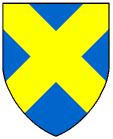
LIVES OF THE BISHOPS OF EXETER
WILLIAM WARELWAST. - Owing to the controversy between the Church and the Crown, concerning the right demanded by the Sovereign of investing bishops and abbots elect with the ring and crosier, the reputed emblems of spiritual jurisdiction, our diocese continued for some years unprovided with a chief pastor. The Popes Gregory VII., Victor III., Urban II., and Pascal II., had uniformly protested against this laical claim, as an innovation and an encroachment on the liberties of the Church. The Sovereign, from whom the prelate elect was to receive the temporalities of his office, unquestionably was entitled to the undivided civil allegiance and homage of his subjects; still, by those who are conversant with the history of these times, it must be admitted that the ulterior claim paved the way to arbitrary exactions, and grievous injuries, and scandalous abuses; and that the poor, who then looked up to the Church for assistance and maintenance, felt as if deprived of their patrimony. King Henry I. had the good sense to relinquish the claim, granted freedom of election to the prelates, and restored Church property to its rightful owners (Wilkins' 'Concilia,' vol. i. p. 387).
The individual now selected to fill the vacant see of Exeter was a special friend of the above-mentioned monarch. His name was William Warelwast, nephew to the Conqueror ("filius sororis Willelmi Conquestoris," says William of Worcester, Itin. p. 100), and had served the two last kings in the quality of chaplain. He had early proved himself a most obsequious courtier; nay, in the autumn of 1095, had treated his primate Anselm at Dover with such vexatious, even rude indignity, as could only be surpassed by the passive submission and meek forbearance of that saintly metropolitan. Probably he now regretted such unclerical proceedings: with four or five other bishops elect he received consecration from the hands of Anselm himself at Canterbury, on Sunday, 11th August, 1107.
From his contemporary Ordericus Vitalis we learn that our bishop accompanied his Sovereign to Normandy in 1113 ('Hist. Eccl.' lib. xi.).
The 'Chronicon' of the Church of Exeter assigns to him the honour of rebuilding the cathedral. Of that structure we have remaining the north and south towers, forming the transepts of the present church, and some traces in the chapels of St. Andrew and St. James, and in the south-east door leading into the cloisters. In the 'Monasticon' of the diocese we have detailed the noble use he made of his ample fortune, in founding Plympton Priory, and in reorganising and endowing the religious houses of Bodmin and Launceston. Dying, according to the Tywardreth obituary, on 26th September, 1137, on 1st October he was buried in the chapter-house of Plympton Monastery (Leland's 'Itin.' vol. iii. p. 33). His effigy on his seal, like that of his immediate predecessor, represents him in his pontifical robes, holding a short simple crook in his left hand, in the act of blessing with the right, and without a mitre. From both King Henry I. and King Stephen he obtained the confirmation of the rights and property of his church; but blindness and the infirmities of advanced age prevented his attesting at Oxford the celebrated charter of King Stephen, which confirmed all the privileges and liberties of the Church of England. Leland's statement "that he abdicated his see to become a canon of Plympton, and that his death occurred in 1127, in the twenty-eighth year of King Henry the First" ('Collectanea,' vol. i. p. 79), is manifestly incorrect.
Arms: - According to Izacke, Azure, a saltier or; but according to Westcote, the better historian of the two (Harl. MS.), Per pale gules and or; in the first two keys paly of the second; the second charged with a sword point in point of the field.
